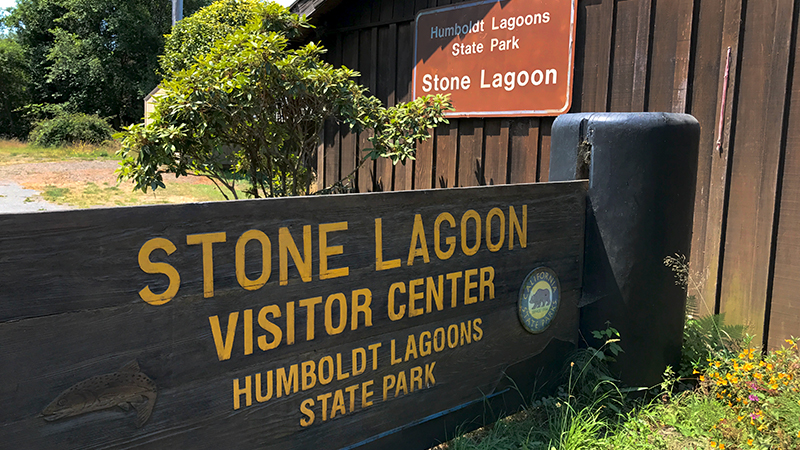
While we didn’t have time for an afternoon of kayaking or stand up paddleboarding on this summers road trip, we did stop in the Stone Lagoon Visitor Center at Humboldt Lagoons State Park to learn more about the lagoons and the surrounding area.
The Stone Lagoon Visitor Center has informational displays about the regional habitat and the large variety of animals that call the lagoons home, a park video, a small gift shop area, and a comfortable seating area where you can rest and look out on the lagoon. There is also a picnic area in the outdoor deck that overlooks the Stone Lagoon.
The Humboldt Lagoons, sitting between Eureka and the Oregon border, are part of the largest lagoon system in North America. In addition to the lagoons, Humboldt Lagoons State Park has six miles of wild and windy Oceanside beaches.
From south to north, Humboldt Lagoons State Park includes:
- Big Lagoon: Frequently breaches its edges after winter rains and is home to thousands of birds that live or migrate through the area.
- Dry Lagoon: Farmers drained this former lake, but their attempts to grow crops failed and today the wetland attracts migrating birds.
- Stone Lagoon: Breaches its 1.5 mile long ocean barrier only every few years. Here you’ll find six boat-in environmental campsites, river otters, Roosevelt elk, the Visitor Center, and Kayak Zak’s where you can rent kayaks or paddleboards, take lessons, or enjoy guided interpretive tours with reservations.
- Freshwater Lagoon: An enclosed lagoon that is co-managed with Redwood National and State Parks. It is stocked with rainbow trout and home to bluegill, catfish, and largemouth bass.
When visiting the Humboldt Lagoons, you can hike the California Coastal Trail and paddle, swim, and fish at the lagoons, and in late spring or early summer, Stagecoach Hill displays vibrant colors along the Azalea Nature Trail.
The Visitor Center History
In the early 1900s, Dry Lagoon was drained by early farmers. Several types of crops were planted, but none were successful. Several dairy ranches were then established along the shores of Stone Lagoon.
Later when the highway was improved, a motel/restaurant called the Little Red Hen was opened next to the lagoon and remained open until 1979. When it closed, the restaurant building was remodeled into a museum and park office. Today the marshland habitat supports a variety of marsh plants, birds, and other animals and the building is now the Stone Lagoon Visitor Center that is run by Kayak Zak’s concession.
Know Before You Go
- Humboldt Lagoons State Park is located at 115336 Highway 101, North Trinidad, California 95570 in Humboldt County just 40 miles north of Eureka and 55 miles south of Crescent City at mile marker 115.3 on Highway 101.
- Download the Humboldt Lagoons Brochure.
- Humboldt Lagoons State Park offers hiking, boating, fishing, camping, birdwatching, whale watching, agate hunting, and a stunning springtime azalea bloom.
- Water activities should only be done in the lagoons. On the ocean side of Humboldt Lagoons, swimming, surfing, and kayaking are not recommended due to big swells, strong currents, and waves that slam onto steep beaches.
- Pick up an Adventure Guide for your kids at the Stone Lagoon Visitor Center or enjoy a picnic at the picnic area and Dry Lagoon day-use area.
- The Stone Lagoon Visitor Center is run by Kayak Zak’s, where you can also rent kayaks and stand up paddleboards and book guided tours.
- Summer is foggy, cool, and damp, with temperatures around 50-60 degrees. Winter is even colder and rainier! if you’re hoping for nice weather, visit during spring and fall.
- Want to see more lagoons? Stop by Big Lagoon County Park, just south of Humboldt Lagoons.



